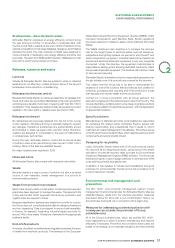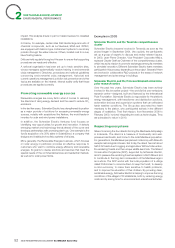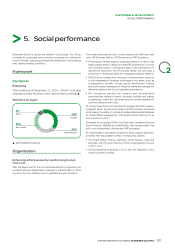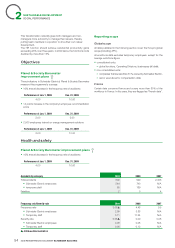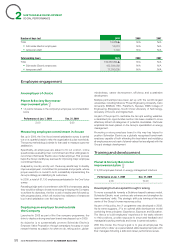APC 2009 Annual Report Download - page 53
Download and view the complete annual report
Please find page 53 of the 2009 APC annual report below. You can navigate through the pages in the report by either clicking on the pages listed below, or by using the keyword search tool below to find specific information within the annual report.
2009 REGISTRATION DOCUMENT SCHNEIDER ELECTRIC 51
SUSTAINABLE DEVELOPMENT
2
ENVIRONMENTAL PERFORMANCE
Southeast Asia – Green the World contest
Schneider Electric organised an energy effi ciency contest during
the year among a number of universities in southeast Asia, with
the fi nal round held in Jakarta at the end of 2009. Finalists from the
national competitions in Indonesia, Malaysia, Singapore and Thailand
attended the event. The inter-university contests were designed to
involve students in developing new energy effi ciency solutions and
proposals. The team from Multimedia University in Malaysia won fi rst
prize with a smart cooling system prototype.
Releases, nuisance and waste
Land use
Virtually all Schneider Electric sites are located in urban or industrial
areas and do not affect any notable biotopes. None of the Group’s
businesses involve extraction or landfarming.
Releases into the water and air
Because Schneider Electric is mainly an assembler, its releases into
the air and water are very limited. Mechanical component production
workshops are carefully monitored, in keeping with their ISO 14001
certifi cation. Their releases are tracked locally as required by current
legislation. No major spills or releases were reported in 2009.
Releases into the soil
No substances are purposely released into the soil in the course
of site operation. Workshop fl ooring is specially treated to prevent
any leakage. Hazardous substances are systematically stored
and handled in areas equipped with retention tanks. Retention
systems are designed to compensate in the event of malfunctions
or emergencies, such as fi res.
During the year, Schneider Electric conducted its annual review
of pollution risks at all manufacturing sites as part of ISO 14001
tracking. None of the sites are classifi ed Seveso.
No major incidents were reported in 2009.
Noise and odors
All Schneider Electric sites comply with noise and odors limits.
Waste
Because waste is a major source of pollution but also a potential
source of raw materials, waste management is a priority in
environmental protection.
Waste from production processes
Most of the Group’s waste is solid waste. Continuous improvement
plans have been deployed to manage this waste. This approach fi ts
in fully with the ISO 14001 approach that all Group production and
logistics sites are required to follow.
Because classifi cation systems vary widely from country to country,
the Group does not consolidate global data by category (hazardous
and non-hazardous). Data is processed to ensure local traceability.
In France, for example, hazardous industrial waste accounts for
around 14% of total waste. All waste is channeled to the appropriate
treatment facility.
End-of-life products
A number of political commitments and regulations address the issue
of waste from electrical products. One example is the European
Waste Electrical and Electronic Equipment directive (WEEE), which
has been transposed in each Member State. Similar regulations
have been adopted or initiated in Japan, China, India and the United
States.
The WEEE directive’s main objective is to increase the recovery
rate for the largest types of electrical waste, such as televisions,
refrigerators and lighting systems, as well as for short-lived IT and
telecommunication equipment. Industrial electrical and electronic
devices and electrical distribution equipment is only very marginally
concerned. Under the directive, the equipment manufacturer is
responsible for setting up and fi nancing dedicated solutions to collect
and process discarded equipment. The directive sets minimum rates
for recovery and recycling.
Schneider Electric is actively involved in a responsible approach even
though virtually none of its products are covered by the directive.
This means that the Group has to be able to demonstrate the
existence of end-of-life solutions that are fi nanced and certifi ed for
collecting, processing and recycling end-of-life products in a way
that respects both human health and the environment.
Carried out in close cooperation with all Group partners, the
approach is deployed at the national level in each host country. This
involves identifying, certifying and in some cases organising solutions
for processing waste from electrical equipment, with the application
of appropriate indicators.
Specific solutions
Manufacturers of batteries and other consumables are responsible
for managing the related waste. Schneider Electric agrees with
sharing responsibility and understands that it needs to inform
customers for waste management to be effective. This is the purpose
of the Product Environmental Profi les, which describe each product’s
components and environmental impact.
Designing for recylability
Lastly, Schneider Electric takes end-of-life environmental impact
into account when designing products, going beyond the simple
calculation of potential recovery rates provided by Environmental
Impact and Management Explorer (EIME) software. The Group has
developed a guide of good design practices to optimise end-of-life
costs and the potential recyclability rate.
In addition, it has decided to include recommendations and good
practices for environmentally friendly end-of-life processing in its
product instruction manuals.
Environmental risk management and
prevention
The ISO 14001 environmental management system covers
management of environmental risks. No Schneider Electric sites are
classifi ed Seveso. Aside from the voluntary prevention measures
discussed above for sites with a soil contamination history, no
amounts have been paid out in connection with a legal ruling.
Measures for addressing accidental pollution with
consequences outside the perimeter of Group
establishments
All of the Group’s industrial sites, which are certifi ed ISO 14001,
have organizations in place to prevent emergencies and respond
effectively if necessary. Preventive and corrective action plans are
based on an analysis of non-standard situations and their potential












